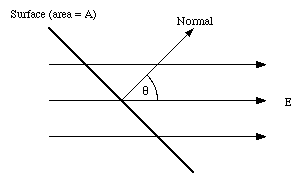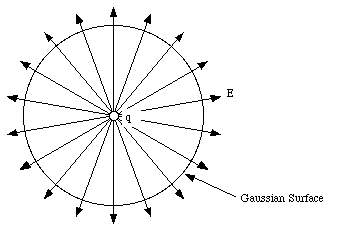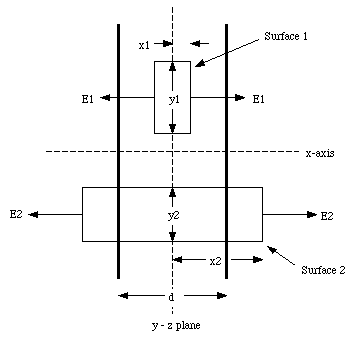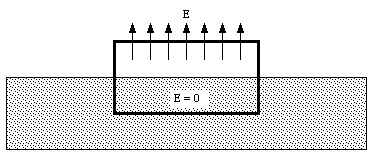
The electric field of a given charge distribution can in principle be calculated using Coulomb's law. The examples discussed in Chapter 23 showed however, that the actual calculations can become quit complicated.
An alternative method to calculate the electric field of a given charge distribution relies on a theorem called Gauss' law. Gauss' law states that
" If the volume within an arbitrary closed mathematical surface holds a net electric charge Q, then the electric flux [Phi] though its surface is Q/[epsilon]0 "
Gauss' law can be written in the following form:



where [theta] is the angle between the electric field and the normal of the surface (see Figure 24.1). To apply Gauss' law one has to obtain the flux through a closed surface. This flux can be obtained by integrating eq.(24.2) over all the area of the surface. The convention used to define the flux as positive or negative is that the angle [theta] is measured with respect to the perpendicular erected on the outside of the closed surface: field lines leaving the volume make a positive contribution, and field lines entering the volume make a negative contribution.
The field generated by a point charge q is spherical symmetric, and its magnitude will depend only on the distance r from the point charge. The direction of the field is along the direction (see Figure 24.2). Consider a spherical surface centered around the point charge q (see Figure 24.2). The direction of the electric field at any point on its surface is perpendicular to the surface and its magnitude is constant. This implies that the electric flux [Phi] through this surface is given by



or

which is Coulomb's law.
Charge is uniformly distributed over the volume of a large slab of plastic of thickness d. The charge density is [rho] C/m3. The mid-plane of the slab is the y-z plane (see Figure 24.3). What is the electric filed at a distance x from the mid-plane ?

As a result of the symmetry of the slab, the direction of the electric field will be along the x-axis (at every point). To calculate the electric field at any given point, we need to consider two separate case: - d/2 < x < d/2 and x > d/2 or x < -d/2. Consider surface 1 shown in Figure 24.3. The flux through this surface is equal to the flux through the planes at x = x1 and x = - x1. Symmetry arguments show that

The flux [Phi]1 through surface 1 is therefore given by

The amount of charge enclosed by surface 1 is given by

Applying Gauss' law to eq.(24.7) and eq.(24.8) we obtain

or

Note: this formula is only correct for - d/2 < x1 < d/2.
The flux [Phi]2 through surface 2 is given by

The charge enclosed by surface 2 is given by

This equation shows that the enclosed charge does not depend on x2. Applying Gauss's law one obtains

or

A large number of electrons in a conductor are free to move. The so called free electrons are the cause of the different behavior of conductors and insulators in an external electric filed. The free electrons in a conductor will move under the influence of the external electric field (in a direction opposite to the direction of the electric field). The movement of the free electrons will produce an excess of electrons (negative charge) on one side of the conductor, leaving a deficit of electrons (positive charge) on the other side. This charge distribution will also produce an electric field and the actual electric field inside the conductor can be found by superposition of the external electric field and the induced electric field, produced by the induced charge distribution. When static equilibrium is reached, the net electric field inside the conductor is exactly zero. This implies that the charge density inside the conductor is zero. If the electric field inside the conductor would not be exactly zero the free electrons would continue to move and the charge distribution would not be in static equilibrium. The electric field on the surface of the conductor is perpendicular to its surface. If this would not be the case, the free electrons would move along the surface, and the charge distribution would not be in equilibrium. The redistribution of the free electrons in the conductor under the influence of an external electric field, and the cancellation of the external electric field inside the conductor is being used to shield sensitive instruments from external electric fields.
The strength of the electric field on the surface of a conductor can be found by applying Gauss' law (see Figure 24.4). The electric flux through the surface shown in Figure 24.4 is given by

where A is the area of the top of the surface shown in Figure 24.4. The flux through the bottom of the surface shown in Figure 24.4 is zero since the electric field inside a conductor is equal to zero. Note that eq.(24.15) is only valid close to the conductor where the electric field is perpendicular to the surface. The charge enclosed by the surface shown in Figure 24.4 is equal to


where [sigma] is the surface charge density of the conductor. Eq.(24.16) is correct if the charge density [sigma] does not vary significantly over the area A (this condition can always be met by reducing the size of the surface being considered). Applying Gauss' law we obtain

Thus, the electric filed at the surface of the conductor is given by
